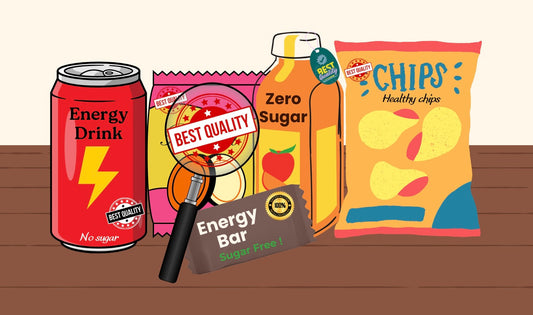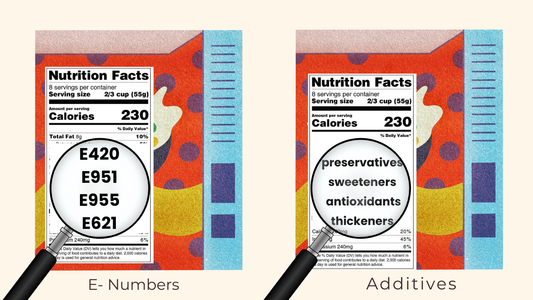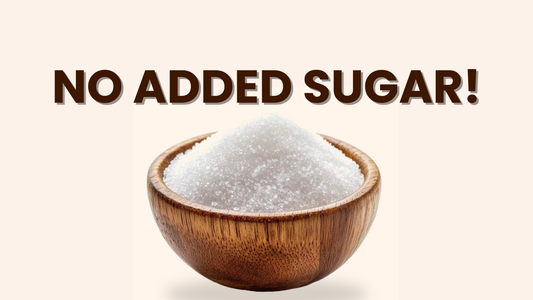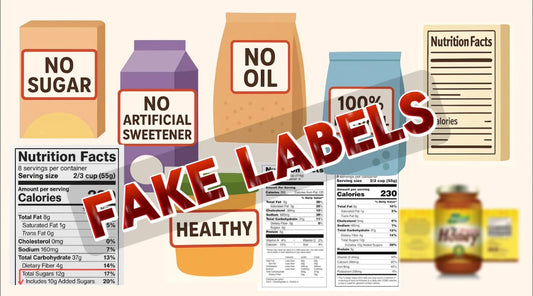Introduction: Why Labels Matter More Than Ever
We live in an age where food packets shout health claims louder than ever. Walk into any supermarket, and you’ll see:
-
“No Added Sugar” juices.
-
“High Protein” biscuits
-
“Low Fat” yogurts.
-
“Digestive” snacks.
But here’s the thing - most of these are marketing slogans, not nutrition facts. If you only read the front of the pack, you’ll get fooled. The real truth is always printed on the back panel - in the nutrition label and ingredient list.
Learning to read that tiny table on the back is like learning a new language. Once you do, you’ll never get tricked again. This blog will teach you exactly how.
Step 1: Always Flip the Pack
Rule number one: ignore the front. The words “healthy,” “natural,” “digestive,” or “organic” are not regulated in India - anyone can use them.
👉 The truth lives on the back - in the nutrition table and the ingredients list.
Step 2: Understand Serving Size Tricks
Most labels show nutrition “per serving.” But here’s the trick:
-
A biscuit packet may say “1 serving = 2 biscuits.” Who eats only 2?
-
A juice box may say “per serving = 100 ml.” But the carton is 200 ml.
👉 Always check the per 100 g/ml values. That’s the international standard and gives you the real picture.
Step 3: Spot the Sugar
Sugar hides under many names. On Indian labels, look for:
-
Sugar, sucrose, fructose, glucose.
-
Jaggery, honey, maltodextrin, corn syrup, fruit concentrate.
If these are in the top three ingredients, it’s a sugar-heavy product.
Quick rule:
-
<5 g sugar per 100 g = low sugar.
-
>10 g sugar per 100 g = high sugar.
👉 Most biscuits, juices, and cereals are 20–30 g sugar per 100 g - basically desserts.
Step 4: Check the Fats
Fat isn’t the enemy - but the type of fat matters.
-
Good fats: nuts, seeds, ghee (in moderation).
-
Bad fats: hydrogenated oils, palm oil, trans fats.
On labels:
-
Look for “hydrogenated” or “partially hydrogenated” → that means trans fats.
-
Palm oil is cheap and common, but not great for heart health.
👉 If trans fat is >0, avoid it.
Step 5: Watch the Salt (Sodium)
Too much salt = high blood pressure risk.
-
<120 mg sodium per 100 g = low.
-
>400 mg = high.
👉 Instant noodles, chips, and packaged snacks often go way above.
Step 6: Protein & Fiber - The Good Guys
While sugar and salt harm, protein and fiber protect.
-
Protein = satiety (keeps you full).
-
Fiber = slows sugar absorption, supports digestion.
On labels:
-
Protein: aim for at least 8–10 g per 100 g in snacks.
-
Fiber: aim for >3 g per 100 g.
👉 Most “digestive biscuits” have only ~1 g fiber. The name is marketing.
Step 7: Don’t Be Fooled by Claims
“No Added Sugar”
Usually replaced with fruit concentrates or jaggery = still sugar.
“Low Fat”
Often means high sugar to make up for taste.
“High Protein”
Check actual protein grams - sometimes it’s less than the sugar.
“Organic”
Doesn’t mean sugar-free or healthy. Organic honey is still sugar.
Step 8: Learn to Decode Ingredients
Ingredients are listed by weight. The first few matter most.
Example:
Biscuit: Wheat flour, sugar, palm oil, glucose syrup, raising agents.
👉 Main ingredient = flour + sugar. Not healthy.
Energy Bar: Oats, sugar, glucose syrup, whey protein.
👉 Looks like “protein bar,” but sugar is #2.
👉 Pro tip: If the ingredient list has more than 8–10 items (flavors, colors, stabilizers) → it’s ultra-processed.
Step 9: Case Studies
Case 1: Fruit Juice
Front: “No Added Sugar. Real Fruit.”
Back: Fruit concentrate, sugar, water.
Sugar: ~25 g per glass.
👉 As much as cola.
Case 2: Breakfast Cereal
Front: “Iron & Vitamins. Whole Grain.”
Back: Corn, sugar, glucose syrup.
Sugar: 28 g per 100 g.
👉 A dessert disguised as breakfast.
Case 3: Digestive Biscuit
Front: “High Fiber. Healthy.”
Back: Refined wheat flour, sugar, palm oil.
Fiber: 1.5 g per 100 g.
Sugar: 22 g per 100 g.
👉 Not digestive, just sweetened maida.
Step 10: Build the Habit
At first, reading labels feels tiring. But soon it becomes instinct.
-
Flip the pack.
-
Check the first 3 ingredients.
-
Check sugar per 100 g.
-
Check sodium and trans fat.
-
Don’t trust the front.
👉 Within weeks, you’ll shop smarter and protect your family’s health.
EPRA Farms: Why We Believe in Clean Labels
We’ve spent months decoding labels ourselves - and were frustrated by the lies. That’s why with EPRA Farms:
-
Ingredients are simple: monk fruit + erythritol.
-
No jaggery, no glucose syrup, no hidden sugars.
-
No “sugar-free” gimmicks with maltodextrin.
-
Transparent, honest, and clean.
Because the best label isn’t the one that shouts “healthy” - it’s the one that doesn’t need to hide.
Final Takeaway
Nutrition labels are like X-rays - they show what’s really inside. Once you learn to read them, marketing loses its power.
-
Don’t trust “healthy” claims.
-
Flip the pack.
-
Check sugars, fats, sodium, protein, and fiber.
-
Learn the sugar aliases.
-
Remember: short ingredient list = better.
👉 Healthy eating isn’t about avoiding all packaged food. It’s about being smart enough to know the truth.
And when you want sweetness without confusion? That’s where monk fruit steps in - clean, natural, and truly safe.





